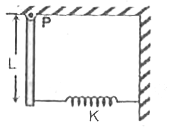One end of a long metallic wire of length (L) is tied to the ceiling. The other end is tied to a massless spring of spring constant . (K.A) mass (m) hangs freely from the free end of the spring. The area of cross- section and the Young's modulus of the wire are (A) and (Y) respectively. If the mass is slightly pulled down and released, it will oscillate with a time period (T) equal to :
2π(m/K)1/2
2π√m((YA+KL))YAK
2π[(mYA/KL)1/2
2π[(mL/YA)1/2
The correct Answer is:B
To solve the problem of finding the time period (T) of the oscillation of a mass attached to a spring and a wire, we will follow these steps:
Step 1: Understand the System
We have a long metallic wire of length L tied to the ceiling, with a spring of spring constant K attached to the free end. A mass m is hanging from the spring. When the mass is pulled down and released, it will oscillate.
Step 2: Identify the Forces
When the mass is displaced, both the spring and the wire will experience tension. The total force acting on the mass when displaced by a distance x can be expressed as:
F=Kx+Fwire
where Fwire is the force due to the extension of the wire.
Step 3: Calculate the Extension of the Wire
The extension (ΔL) of the wire can be calculated using Young's modulus (Y):
Y=F/AΔL/L
Rearranging gives:
F=YAΔLL
Here, A is the cross-sectional area of the wire.
Step 4: Relate Forces to Spring Constant
The effective spring constant K′ of the wire can be expressed as:
K′=YAL
Thus, the total effective spring constant Keq of the system (spring and wire) when combined in series is:
1Keq=1K+1K′
Substituting K′:
1Keq=1K+LYA
Step 5: Calculate the Time Period
The time period T of a mass-spring system is given by:
T=2π√mKeq
Substituting for Keq:
T=2π
⎷m(1K+LYA)−1
Step 6: Simplify the Expression
After simplification, we can express T as:
T=2π√m(KYAKY+L)
Final Expression
Thus, the time period T of the oscillation is:
T=2π√m(KL+YA)KYA
We have a long metallic wire of length L tied to the ceiling, with a spring of spring constant K attached to the free end. A mass m is hanging from the spring. When the mass is pulled down and released, it will oscillate.
When the mass is displaced, both the spring and the wire will experience tension. The total force acting on the mass when displaced by a distance x can be expressed as:
F=Kx+Fwire
where Fwire is the force due to the extension of the wire.
The extension (ΔL) of the wire can be calculated using Young's modulus (Y):
Y=F/AΔL/L
Rearranging gives:
F=YAΔLL
Here, A is the cross-sectional area of the wire.
The effective spring constant K′ of the wire can be expressed as:
K′=YAL
Thus, the total effective spring constant Keq of the system (spring and wire) when combined in series is:
1Keq=1K+1K′
Substituting K′:
1Keq=1K+LYA
The time period T of a mass-spring system is given by:
T=2π√mKeq
Substituting for Keq:
T=2π
⎷m(1K+LYA)−1
After simplification, we can express T as:
T=2π√m(KYAKY+L)
Thus, the time period T of the oscillation is:
T=2π√m(KL+YA)KYA
Topper's Solved these Questions
Similar Questions
An object of mass m is suspended at the end of a massless wire of length L and area of cross -section A. Young modulus of the material of the wire is Y. If the mass is pulled down slightly its frequency of oscillation along the vertical direction is :
View SolutionA straight rod of light L and mass m is pivoted freely from a point of the roof. Its lower end is connected to an ideal spring of spring constant K. The other end of the spring is connected to the wall as shown in the figure. Find the frequency of small oscillation of the system.

View Solution
Knowledge Check
One end of a long mettalic wire of length L is tied to the ceiling. The other end is tied to massless spring of spring constant K. A mass M hangs freely from the free end of the spring. The area of cross-section and Young's modulus of the wire are A and Y respectively. If the mass is slightly pulled down and released, it will oscillate with a time period T equal to
A2π√(M/K)B2π√M(YA+KL)/YAKC2π√(MYA/KL)D√(ML/YA)A metal wire of length L, area of cross-section A and Young's modulus Y behaves as a spring of spring constant k.
Ak=YA/LBk=2YA/LCk=YA/2LDk=YL/AIf a metal wire of length L, having area of cross-section A and young' s modulus Y . Behave as a spring of spring constant K. The value of K is
AYALBYA2LC2YALDYLA
If a metal wire of length L, having area of cross-section A and Young's modulus Y, behaves as a spring constant K. The value of K is
View SolutionA block of mass M is suspended from a wire of length L, area of cross-section A and Young's modulus Y. The elastic potential energy stored in the wire is
View SolutionA uniform wire of mass m, length L, area of cross-section A and Young's modulus Y hange from the ceiling. Its elongation under its own weight will be
View SolutionA mass (m) is suspended at the end of a weightless wire of length L, cross-sectional area A and Young's modulus Y. The period of oscillation for the S.H.M. along the vertical direction is
View SolutionA mass (m) is suspended at the end of a weightless wire of length L, cross-sectional area A and Young's modulus Y. The period of oscillation for the S.H.M. along the vertical direction is,
View Solution
